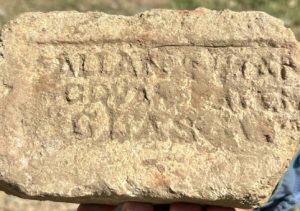Alexander Munro – Cathcart, Lanarkshire, Scotland to Pennsylvania, USA
Alexander Munro.
Born 9 Oct 1805 Cathcart, Lanark, Scotland.
Death 5 Apr 1872 Lock Haven, Clinton Co., Pennsylvania.
He started the first fire brick manufacturing plant in Pennsylvania (1838) at Farrandsville about seven miles from Lock Haven.
History of the Farrandsville Iron Furnace – Financed by a group of Boston Capitalists, construction of the historic Farrandsville Iron Furnace was begun in the winter of 1836 under the supervision of its designer, Edward Thomas of Wales. Utilizing stone mined at the quarry located on the mountain directly behind the site, the master mason, John P. Salmon of England, and his crew of skilled stone cutters completed the 54 foot high (including the chimney stack) blast furnace by early 1837. The usual blast equipment, a large bellows operated by a water wheel, was on place. However in 1828 in Scotland, James B. Neilson had become the first to use hot blast in a furnace, an innovation which would work such a revolution in the iron trade, and another Scot, James Ralston, had put it into practical operation at the Clyde Iron Company in Dunlap, Scotland. An agent of the Farrandsville Iron Company visited Mr Ralston in 1836 and enticed him to come to America. Taking passage on the South Carolina Ship “ Leonore” with the hot blast pipes manufactured in Glasgow, Mr Ralston arrived in New York City in February of 1837 and at Farrandsville, via the West Branch Canal, by that Spring. Here, at the recently completed furnace, he superintended the erection of machinery and started the first successful hot blast, not only in America but in the continent. After the furnace had been in blast a time, the “pig” iron produced was of superior quality as foundry iron, the yield being about 50 tons per week. The blast was propelled by 170 horsepower which was generated by a steam engine having 10 boilers. A higher quality iron ore was transported from Montour Ridge in Columbia County while the limestone came from Nittany Valley. The fuel was coke and was made from the bituminous coal mined at Minersville, atop the mountain adjacent to the furnace, from whence also came the fire – brick which would line the interior stack in future years. The furnace is one of the largest early furnaces still in existence in America and, since mortar was not used, is an outstanding example of dry masonry. The furnace was deeded to the Clinton County Historical Society on September 28, 1951, by the Harbison – Walker Refractories Company.
The village of Farrandsville was founded in early 1832 and owes its beginning to William P. Farrand, an enterprising man of scientific achievements who was a representative of the Lycoming Coal Company which was financed by a group of Boston Capitalists. For about 2 decades, Farrandsville was the industrial giant of what is now Clinton County. In 1839 Alexander Munro, a Scotsman, at the aforementioned Minersville, built the first plant in Pennsylvania specifically designed to manufacture fire – brick. About a mile west of Farrandsville, a very large and elaborately furnished mansion was built for Queen Maria Christina of Spain by John & Christopher Fallon, her agents in America, using a portion of the money attained by Spain for the sale of Florida to the United States.
Alexander Munro











